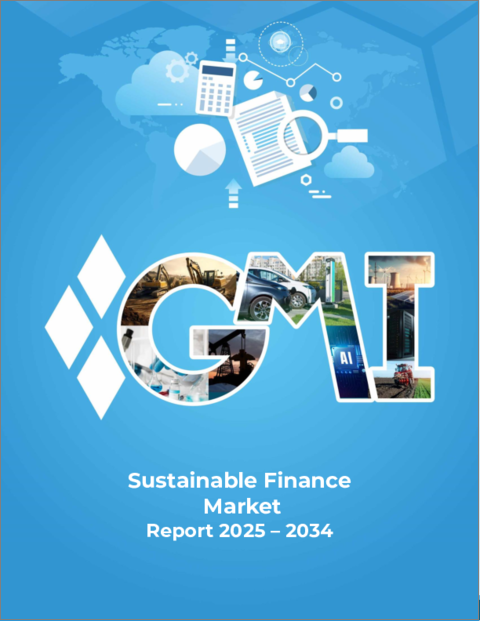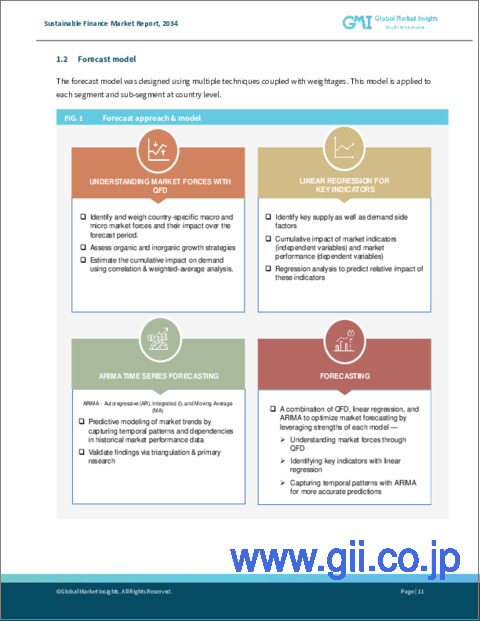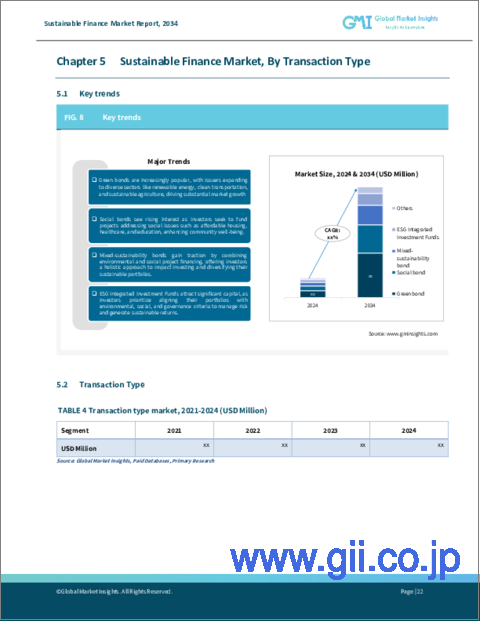|
|
市場調査レポート
商品コード
1536053
サステナブルファイナンスの市場規模:投資タイプ別、取引タイプ別、投資家タイプ別、最終用途別、予測、2024年~2032年Sustainable Finance Market Size - By Investment Type, By Transaction Type, By Investor Type, By End-use & Forecast, 2024 - 2032 |
||||||
カスタマイズ可能
|
|||||||
| サステナブルファイナンスの市場規模:投資タイプ別、取引タイプ別、投資家タイプ別、最終用途別、予測、2024年~2032年 |
|
出版日: 2024年06月26日
発行: Global Market Insights Inc.
ページ情報: 英文 240 Pages
納期: 2~3営業日
|
- 全表示
- 概要
- 目次
サステナブルファイナンスの市場規模は、環境的・社会的に責任ある投資慣行に対する認識と需要の高まりに牽引され、2024年から2032年にかけてCAGR 22%以上で成長すると予想されます。
投資家が金融上の意思決定が気候変動、社会的公正、コーポレート・ガバナンスに与える影響を意識するようになり、持続可能性の基準に沿った投資へのシフトが進んでいます。例えば、ドイツ銀行は2024年7月、BASFがアジアで初めて導入した持続可能性に連動した支払債務ファイナンス・プログラムを、特に中国事業向けに導入しました。
企業はまた、持続可能な慣行がリスクの軽減、業務効率の改善、ブランド評価の向上など、長期的な財務的利益につながることを認識するようになっています。このような企業のシフトは、持続可能な開発目標を支援し、企業の社会的責任(CSR)目標に沿った持続可能な金融商品やサービスへの需要を促進しています。
環境・社会・ガバナンス(ESG)要素を優先する企業への投資機会を投資家に複数提供する必要性から、投資ベースのサステナブル金融市場規模は2024年から2032年にかけて拡大する見通しです。株式投資家がポートフォリオを持続可能性の目標に沿わせることを求めるようになっているため、ESG基準を満たす株式やファンドに対する需要が高まっています。
輸送・物流最終用途部門のサステナブルファイナンス市場は、環境に優しく効率的な輸送ソリューションへの多額の投資により、2024年から2032年にかけて大きなCAGRを記録するとみられます。輸送・ロジスティクス分野は、カーボンフットプリントの削減と環境パフォーマンスの向上に対するプレッシャーが高まる中、企業は電気自動車やハイブリッド車の開発、サプライチェーンの最適化、グリーンインフラの導入などの取り組みに資金を提供するため、持続可能な金融オプションに目を向けています。
アジア太平洋地域のサステナブルファイナンス業界は、急速な都市化と大気汚染や気候変動などの環境課題に対処する緊急の必要性から、2024年から2032年にかけて顕著な成長を遂げると予想されます。同地域の政府や金融機関は、グリーン投資や持続可能なインフラ・プロジェクトを支援する政策やインセンティブを導入する動きを強めており、同地域の市場成長をさらに刺激しています。
目次
第1章 調査手法と調査範囲
第2章 エグゼクティブサマリー
第3章 業界洞察
- エコシステム分析
- サプライヤーの状況
- 金融機関
- テクノロジー・プロバイダー
- 法律・規制アドバイザー
- コンサルティング会社
- 政府機関
- 利益率分析
- 技術とイノベーションの展望
- 特許分析
- 主要ニュース&イニシアチブ
- 規制状況
- 影響要因
- 促進要因
- 環境・社会問題に対する意識の高まり
- 持続可能性に対する政府・国民の意識の高まり
- 世界の持続可能性に関する規制の高まり
- 企業の好感度向上への関心の高まり
- 業界の潜在的リスク&課題
- サステナブルファイナンスの多様化の問題
- 進化する規制環境
- 促進要因
- 成長可能性分析
- ポーター分析
- PESTEL分析
第4章 競合情勢
- イントロダクション
- 企業シェア分析
- 競合のポジショニング・マトリックス
- 戦略展望マトリックス
第5章 市場推計・予測:投資タイプ別、2021年~2032年
- 主要動向
- エクイティ
- 債券
- ミックスアロケーション
- その他
第6章 市場推計・予測:取引タイプ別、2021年~2032年
- 主要動向
- グリーンボンド
- ソーシャルボンド
- ミックス・サステナビリティ・ボンド
- ESG統合投資ファンド
- その他
第7章 市場推計・予測:投資家タイプ別、2021年~2032年
- 主要動向
- 機関投資家
- 小口投資家
第8章 市場推計・予測:最終用途別、2021年~2032年
- 主要動向
- ユーティリティ
- 輸送・物流
- 化学
- 飲食品
- 政府機関
- その他
第9章 市場推計・予測:地域別、2021年~2032年
- 主要動向
- 北米
- 米国
- カナダ
- 欧州
- 英国
- ドイツ
- フランス
- イタリア
- スペイン
- ロシア
- 北欧
- その他欧州
- アジア太平洋
- 中国
- インド
- 日本
- 韓国
- ニュージーランド
- 東南アジア
- その他アジア太平洋地域
- ラテンアメリカ
- ブラジル
- メキシコ
- アルゼンチン
- その他ラテンアメリカ
- 中東・アフリカ
- UAE
- 南アフリカ
- サウジアラビア
- その他の中東・アフリカ
第10章 企業プロファイル
- Acuity Knowledge Partners
- Aspiration Partners, Inc.
- Bank of America
- BlackRock
- BNP Paribas
- Clarity AI
- Deutsche Bank AG
- Goldman Sachs
- HSBC Group
- KPMG International
- NOMURA HOLDINGS, INC
- Refinitiv
- South Pole
- Starling Bank
- Stripe, Inc.
- Tred Earth Limited
- Triodos Bank UK Ltd.
- UBS
Sustainable finance market size is anticipated to grow at over 22% CAGR between 2024 and 2032 driven by increasing awareness and demand for environmentally and socially responsible investment practices. As investors are becoming more conscious of the impacts of their financial decisions on climate change, social equity, and corporate governance, there is growing shift towards investments that align with sustainability criteria. For instance, in July 2024, Deutsche Bank introduced BASFs inaugural sustainability-linked payables finance program in Asia, specifically for its operations in China for adhering to global standards while customizing to meet the local business needs.
Companies are also increasingly recognizing that sustainable practices can lead to long-term financial benefits, including risk mitigation, improved operational efficiency, and enhanced brand reputation. This corporate shift is driving the demand for sustainable financial products and services that support sustainable development goals and align with corporate social responsibility (CSR) objectives.
The overall industry is segmented into investment type, transaction type, investor type, end use, and region.
Based on investment, the sustainable finance market size from the equity segment is poised to grow between 2024 and 2032 favored by the need for offering investors multiple opportunities to participate in companies that prioritize environmental, social, and governance (ESG) factors. As equity investors are increasingly seeking to align their portfolios with sustainability goals, there is rising demand for stocks and funds that meet the ESG criteria.
Sustainable finance market from the transport & logistics end use segment is set to witness significant CAGR from 2024 to 2032 owing to the significant investments into eco-friendly and efficient transportation solutions. As the sector transport & logistics faces increasing pressure to reduce its carbon footprint and improve environmental performance, companies are turning to sustainable finance options to fund initiatives, such as the development of electric and hybrid vehicles, the optimization of supply chains, and the implementation of green infrastructure.
Asia Pacific sustainable finance industry is expected to accrue notable growth from 2024 to 2032 attributed to rapid urbanization and the urgent need to address environmental challenges, such as air pollution and climate change. Governments and financial institutions in the region are increasingly implementing policies and incentives to support green investments and sustainable infrastructure projects, further stimulating the regional market growth.
Table of Contents
Chapter 1 Methodology & Scope
- 1.1 Market scope & definition
- 1.2 Research design
- 1.2.1 Research approach
- 1.2.2 Data collection methods
- 1.3 Base estimates & calculations
- 1.3.1 Base year calculation
- 1.3.2 Key trends for market estimation
- 1.4 Forecast model
- 1.5 Primary research and validation
- 1.5.1 Primary sources
- 1.5.2 Data mining sources
Chapter 2 Executive Summary
- 2.1 Industry 360° synopsis, 2021 - 2032
Chapter 3 Industry Insights
- 3.1 Industry ecosystem analysis
- 3.2 Supplier landscape
- 3.2.1 Financial institutions
- 3.2.2 Technology providers
- 3.2.3 Legal and regulatory advisors
- 3.2.4 Consulting firms and advisories
- 3.2.5 Government agencies
- 3.3 Profit margin analysis
- 3.4 Technology & innovation landscape
- 3.5 Patent analysis
- 3.6 Key news & initiatives
- 3.7 Regulatory landscape
- 3.8 Impact forces
- 3.8.1 Growth drivers
- 3.8.1.1 Growing awareness about environmental and social issues
- 3.8.1.2 Increasing government and public awareness towards sustainability
- 3.8.1.3 Rising global sustainability regulations
- 3.8.1.4 Rising focus of businesses towards enhancing their goodwill
- 3.8.2 Industry pitfalls & challenges
- 3.8.2.1 Diversification issues of sustainable finance
- 3.8.2.2 Evolving regulatory environment
- 3.8.1 Growth drivers
- 3.9 Growth potential analysis
- 3.10 Porter's analysis
- 3.11 PESTEL analysis
Chapter 4 Competitive Landscape, 2023
- 4.1 Introduction
- 4.2 Company market share analysis
- 4.3 Competitive positioning matrix
- 4.4 Strategic outlook matrix
Chapter 5 Market Estimates & Forecast, By Investment Type, 2021 - 2032 ($Bn)
- 5.1 Key trends
- 5.2 Equity
- 5.3 Fixed income
- 5.4 Mixed allocation
- 5.5 Others
Chapter 6 Market Estimates & Forecast, By Transaction Type, 2021 - 2032 ($Bn)
- 6.1 Key trends
- 6.2 Green bond
- 6.3 Social bond
- 6.4 Mixed- sustainability bond
- 6.5 ESG Integrated Investment Funds
- 6.6 Others
Chapter 7 Market Estimates & Forecast, By Investor Type, 2021 - 2032 ($Bn)
- 7.1 Key trends
- 7.2 Institutional investors
- 7.3 Retail Investors
Chapter 8 Market Estimates & Forecast, By End-use, 2021 - 2032 ($Bn)
- 8.1 Key trends
- 8.2 Utilities
- 8.3 Transport & logistics
- 8.4 Chemicals
- 8.5 Food and beverage
- 8.6 Government
- 8.7 Others
Chapter 9 Market Estimates & Forecast, By Region, 2021 - 2032 ($Bn)
- 9.1 Key trends
- 9.2 North America
- 9.2.1 U.S.
- 9.2.2 Canada
- 9.3 Europe
- 9.3.1 UK
- 9.3.2 Germany
- 9.3.3 France
- 9.3.4 Italy
- 9.3.5 Spain
- 9.3.6 Russia
- 9.3.7 Nordics
- 9.3.8 Rest of Europe
- 9.4 Asia Pacific
- 9.4.1 China
- 9.4.2 India
- 9.4.3 Japan
- 9.4.4 South Korea
- 9.4.5 ANZ
- 9.4.6 Southeast Asia
- 9.4.7 Rest of Asia Pacific
- 9.5 Latin America
- 9.5.1 Brazil
- 9.5.2 Mexico
- 9.5.3 Argentina
- 9.5.4 Rest of Latin America
- 9.6 MEA
- 9.6.1 UAE
- 9.6.2 South Africa
- 9.6.3 Saudi Arabia
- 9.6.4 Rest of MEA
Chapter 10 Company Profiles
- 10.1 Acuity Knowledge Partners
- 10.2 Aspiration Partners, Inc.
- 10.3 Bank of America
- 10.4 BlackRock
- 10.5 BNP Paribas
- 10.6 Clarity AI
- 10.7 Deutsche Bank AG
- 10.8 Goldman Sachs
- 10.9 HSBC Group
- 10.10 KPMG International
- 10.11 NOMURA HOLDINGS, INC
- 10.12 Refinitiv
- 10.13 South Pole
- 10.14 Starling Bank
- 10.15 Stripe, Inc.
- 10.16 Tred Earth Limited
- 10.17 Triodos Bank UK Ltd.
- 10.18 UBS





